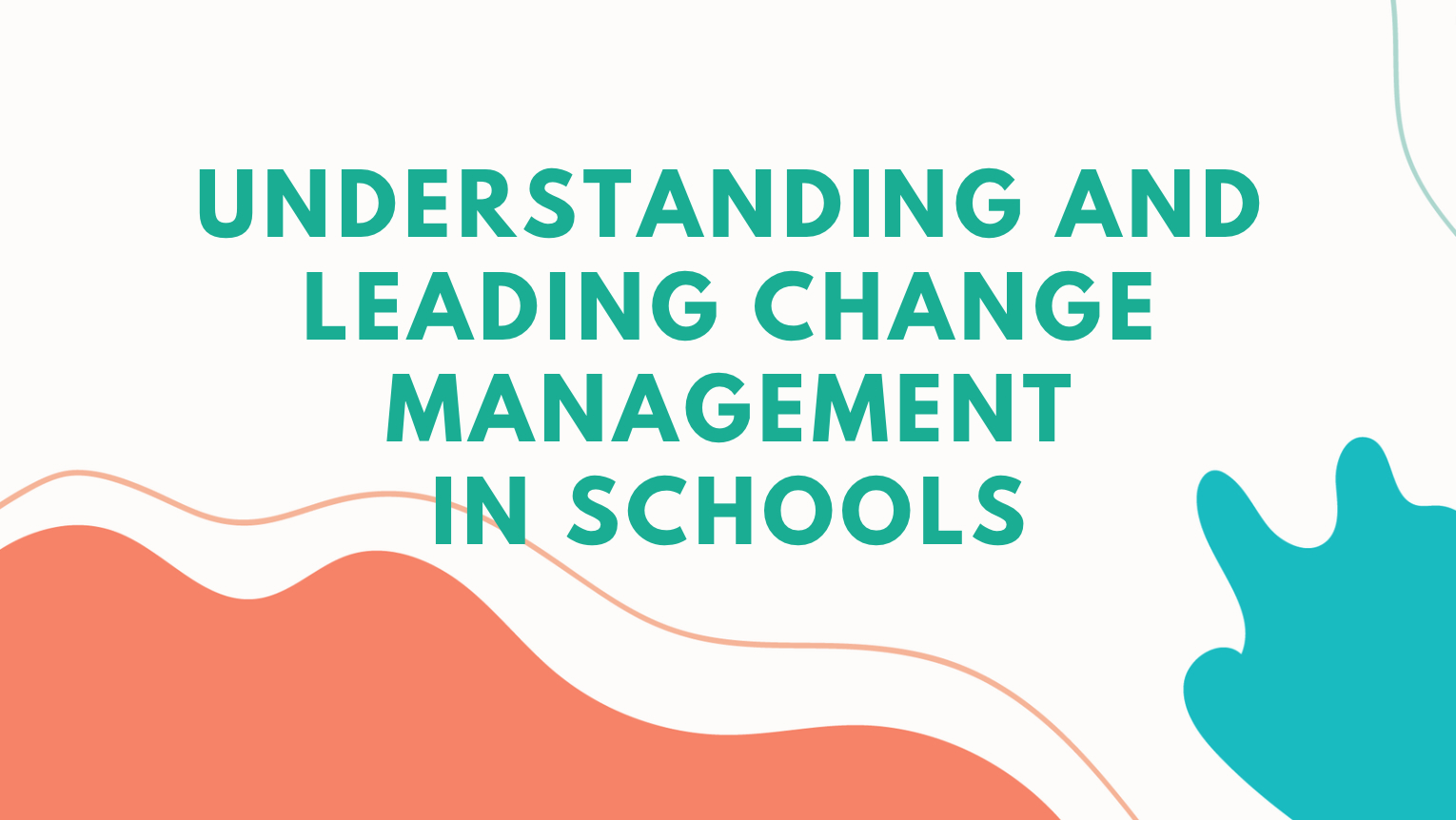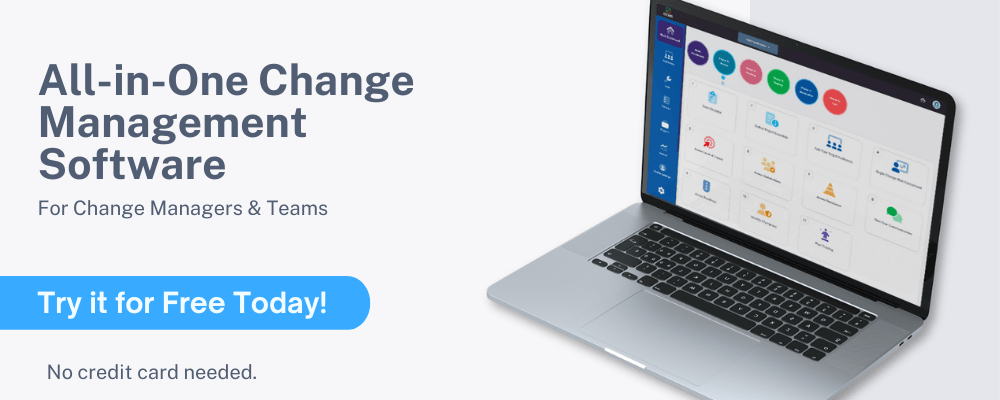Understanding and Leading Change Management in Schools. Complete Guide of Everything You Need to Know
 Embracing Change: A Friendly Guide to Change Management in Education Institutions
Embracing Change: A Friendly Guide to Change Management in Education Institutions
In the realm of education, where curiosity meets classroom, organizational change management is the secret sauce that ensures our educational institutions stay ahead of the curve. So, grab your metaphorical backpacks, and let’s explore the ins and outs of making change not just a necessity but a beacon of progress in our beloved education settings.
Change management is like the friendly school bus that takes us to new and exciting destinations.
From understanding the intricacies of the Prosci ADKAR® Change Management Model to learning invaluable tips from seasoned educators, we’ve got your back on this adventure. So, buckle up and let’s embark on this adventure together, where every twist and turn brings us closer to a brighter, more vibrant educational landscape. Get ready to ignite inspiration, foster collaboration, and empower positive change in the heart of education!
Eager to uncover the path that lies ahead? We’ve put together a concise overview just for you. Brace yourself to delve into the complexities of change management within educational institutions, knowing that we’re here to accompany you on this enlightening expedition.
Quick Summary
Revitalizing Learning: Understanding the Importance of Change in Education
Change is crucial in education for several reasons. At the start of each school year, ongoing organizational change is evident, involving the constant turnover of students and staff. Beyond these routine changes, there is a need for more deliberate change management in areas such as technology and curriculum. Without updates and improvements, schools risk becoming less effective, leading to potential declines in educational outcomes. Implementing change is essential to introduce new educational methods and technologies, ensuring that students and staff can adapt to an ever-evolving world and remain competitive.
Strategic Upgrades: Improving Schools for Tomorrow’s Learners
Changes in schools should be tailored to the specific needs of each institution. Universities might need to reconsider tuition policies to compete locally, while elementary schools may focus on diversifying their curriculum. Successful change management in education should be driven by a mission to enhance the educational experience rather than purely for financial reasons, as the latter may lead to resistance and implementation challenges.
Common changes discussed in schools for effective change management include:
- Enhancing student health through increased physical activity.
- Incorporating more life skills into the curriculum.
- Updating the curriculum based on recent studies.
- Reimagining the structure of the school year.
- Implementing procedural changes to enhance safety and prevent incidents.
- Integrating online and offline instruction methods.
- Improving working conditions for teachers.
- Adjusting physical environments to accommodate social distancing.
- Enhancing school communications through the use of technology.
Adapting to Progress: Decoding Change Management in Education
Change management in education involves the systematic process of preparing an organization for upcoming changes, developing an implementation plan for leading change in schools, and executing the change. It requires a solid understanding of change management basics and models that provide a framework, applicable to both primary and higher education.
To prevent changes from failing or yielding undesired outcomes, it’s crucial to follow change management best practices. This includes considering stakeholders (students, teachers, staff, parents) and outlining procedures for leading change in education. Successful change management in educational institutions employs tools and methodologies to effectively implement and sustain change.

From Vision to Reality: The Journey of Implementing Change in Education
Implementing change in education involves both processes and people. Regardless of the chosen change management model (e.g., ADKAR, Bridges, Lewin), the process resembles project planning. The key processes in change management for schools include:
- Information Gathering & Prep:
- Impact Assessment
- Readiness Assessment
- Project Assessment
- Stakeholder Analysis
- Creating a Change Champion Network
- Preparing for Resistance Management
- Creating a Change Management Roadmap
- Execution of Change in Education:
- Change Training Plan
- Communications Plan
- Coaching Leadership
- Stakeholder Management
- Reinforcing the Change in Education:
- Regular check-ins with teachers
- Creating a change management FAQ page
- Requesting stakeholder feedback
- Offering support for questions about organizational change in education
Successfully leading change in education requires ongoing support and reinforcement to ensure that new procedures are sustained and that individuals don’t revert to old habits after the initial implementation. The process involves continuous communication, adaptation to feedback, and providing necessary resources and support to stakeholders throughout the change management journey.
Championing Change in Schools: Insights, Strategies, and Tips for Educational Transformation
Implementing change in schools involves addressing the “people” aspect, which is crucial given natural resistance to change. Managing stakeholders’ experiences, feelings, and individual processes during the implementation of change in schools is essential. The Prosci ADKAR® Model provides a framework for guiding people through various phases to achieve organizational change in education:
- Awareness of the change
- Desire to change and adopt the new process
- Knowledge of how they will go through that change
- Ability and skills for the new process
- Reinforcement and support to sustain the change
Dr. Richard Steward, a headteacher at The Woodroffe School, offers tips for change management in education, emphasizing the importance of adapting to constant change, developing coping strategies, delegating duties, staying calm during adjustments, and seeking ideas through school-to-school collaboration.
Promoting change in education requires a collective effort, with teachers playing a vital role in sustaining and leading change in their classrooms. Tips for teachers include setting a positive example, updating rules and guidelines, consistent communication about the change and its benefits, and using positive reinforcement to motivate students to embrace and sustain new behaviors.
Detailed Deep Dive
Educational institutions, just like all other organizations, undergo change regularly. But change doesn’t necessarily bring improvement. It all depends upon how well implementing change in schools is done.
Change in educational institutions may be due to new state educational requirements, introducing new technology into the classroom, or updates in textbooks and teaching methods.
One of the biggest impacts seen recently that calls for leading change in schools has been the coronavirus pandemic, which completely changed the educational process for students and teachers around the world.
Organizational change in education doesn’t just happen by giving a school the new process, tools, or methods they need to change to; it has to be guided with the best change management strategies.

Change Management in Education
Change management in higher education, as well as primary grades, involves several steps to successfully guide an institution or school district through a change.
What You Will Learn
In this article, we’ll look at the importance of change management in the education sector, and answer several important questions, including:
- Why is change important in education?
- What changes should be made in schools?
- What is the best process for implementing changes in education?
- How do you implement change in schools? (The people)
- What are some teacher tips? How do headteachers manage change in schools?
- How do you promote change in education?
Anyone leading change in education knows that change only happens when people change their habits, and change management is focused on that fact.
Teachers, administrators and staff, students, and parents can all be impacted by a change, and need to be considered when leading and managing change in educational institutions. The process involves unmolding old behaviors, training new practices and behaviors, and then reinforcing the new way of doing things.
Successfully guiding people through that change process is the goal of change management in educational institutions.
See Also: Best Guide for Transformational Leadership in Education & Schools
Do you have questions on educational change management or the types of change in education found in this guide? We’d love to hear from you, click here to contact us.
Why is Change Important in Education?
If you look at what schools go through at the beginning of any new school year, you can say that organizational change in education is happening continually.
Students are graduating and leaving, new students are enrolling, and everyone moving up is changing their classroom and teachers. But beyond the student and staff changes, there are also other types of change, the kind that requires change management in schools and change management in higher education.
Without upgrades to technology, curriculum, and other ways of doing things, schools become less effective, and educational outcomes can suffer.
Implementing change in schools is vital so that students and staff can benefit from new educational methods, new technologies, and can keep their students learning the things they need to in order to stay competitive in an ever-evolving world.
What Changes Should Be Made in Schools?
The factors leading change in schools can differ according to each educational institution. A university may need to rethink their tuition policies to compete with local colleges. Certain elementary schools may be leading change in education policies to ensure the curriculum is appropriately diverse.
It’s important to the success of a change project that leading and managing change in education is done with a mission to make things better. If change management in educational institutions is done only for monetary reasons (i.e., to cut costs), then there’s likely to be resentment and difficulty making the change stick.
Some of the common changes discussed in schools when it comes to change management in educational institutions include:
- Improving student health (i.e., adding more physical activity)
- Teaching more life skills
- Improvements to curriculum based upon recent studies
- Reimagining of how the school year is structured
- Procedural changes to prevent shooting incidents
- Incorporating online with offline instruction
- Improving teacher working conditions
- Adjusting physical environments for social distancing
- Improving school communications through the use of technology
Don’t Miss: Key Roles of Leadership in Change Management | All You Need to Know
Got questions like “What is higher education change management?” or “What is the change management process in education?”. Drop us a message and let us know.
What is Change Management in Education?
Change management in education is the process of adequately preparing an organization for the upcoming change, creating an implementation plan for leading change in schools, and implementing the change.
Change management in schools requires knowledge of the basics of change management, including change models that can provide a framework for change management in primary and change management in higher education.
Implementing change in schools can easily go “off the rails” and cause a change to fail or not produce the desired results. People can be confused about what to do, resist the change altogether, or have inadequate training on the new process.
Organizational change in education is easier when people leading and managing change are using change management best practices.
This includes an outline of procedures for leading change in education that takes the stakeholders (student, teachers, staff, parents) into consideration. Successful change management in educational institutions uses change tools and methodologies to implement and sustain a change.

Managing Change in Schools
How Do You Implement Change in Education? | The Processes
Anyone leading and managing change in education using a change management model will see that activities involve both people and processes. We’ll discuss the processes first, then move onto the “people” part of the change.
Whichever change management model you choose to use (ADKAR, Bridges, Lewin, etc.), there will be certain processes you need to go through that will be similar to a project planning process.
Here is an overview of the types of processes you’ll need to go through when planning change management in schools.
Information Gathering & Prep
Before you can implement change management in higher education or elementary school levels, you should understand how the change will impact the stakeholders. This allows you to head off any potential resistance and ensure your training process will be adequate.
When implementing change in schools, some of the processes in this information gathering & prep stage include:
- Impact Assessment
- Readiness Assessment
- Project Assessment
- Stakeholder Analysis
- Creating a Change Champion Network
- Preparing for Resistance Management
- Creating a Change Management Roadmap
Execution of Change in Education
Executing change management in schools is the “doing” part of your change management process. This is when you’ll be implementing change in schools’ procedures or processes according to your roadmap.
This requires excellent communication, awareness of how the change is being received, and the ability to adjust your organizational change in education according to the circumstances.
Some of the processes you’ll go through while leading change in schools during this stage include:
Reinforcing the Change in Education
When you’re leading a change in education, it’s easy for people to fall back into old habits and not sustain the new procedures if you haven’t gone through the reinforcement stage of leading and managing change in education.
Too often, people think that after the “go-live” date, their job is done as far as change management in educational institutions goes. But people that have gone through the change need to have continued support to help “freeze” those new behaviors.
Some of the ways you can help reinforce change management in higher education, high schools, and primary schools are:
- Continue to check in regularly with teachers to see how things are going.
- Create a change management in education FAQ page as a helpful resource.
- Request stakeholder feedback to assess change management in schools.
- Offer support for stakeholders with questions about the organization change in education they’ve just gone through.
Related: Best Guide for Improving Healthcare Leadership in Healthcare & Social Care
Are you looking answers to questions like “What is change management for higher education?” or “Types of management of educational institutions?”. Send us a message with your questions or comments.
How Do You Implement Change in Schools? | The People
The “people” part of change is perhaps the biggest job when dealing with change management in education. People are naturally resistant to change, so managing their experience and feelings about the change is important.
People are going through their own individual process while you are implementing change in schools, so their resistance, fears, anxiety, and other change-related feelings need to be addressed.
One of the models that helps visualize the journey you need to take stakeholders through when implementing change management in schools is called the Prosci ADKAR® Model.
Each letter provides a phase that people need to be guided through to achieve organizational change in education:
- Awareness of the change
- Desire to change and adopt the new process
- Knowledge of how they will go through that change
- Ability and skills for the new process
- Reinforcement and support to sustain the change
Teacher Tips: How Do Headteachers Manage Change in School?
In reviewing change management in higher education and primary education, we found some tips from a headteacher on how to handle change management in schools.
Dr. Richard Steward, a headteacher at The Woodroffe School, offered the following tips to educators for change management in education:
- Remember that change is constant
- Develop coping strategies to manage rapid organizational change in education
- Delegate duties involved in change management in schools
- Don’t panic! A change project can be adjusted if things aren’t going as planned
- Use school-to-school collaboration for ideas from others on change management in education
How Do You Promote Change in Education?
Once a change has been implemented that impacts students, how can teachers help promote that change in education processes?
Change management in schools requires an “all hands on deck” approach. While those managers implementing change in schools can help drive the change and make it happen, teachers are often needed to promote the change daily until it sticks with students.
Here are some tips for teachers for promoting, sustaining, and leading a change in schools in their classrooms.
- Set a Good Example: If students see a teacher doing something the “old way,” they’ll think it’s okay to do that too. It’s essential to model a positive change example.
- Set Clear Rules & Guidelines: If rules need to be updated due to organizational change in education, make sure they’re changed accordingly, so there are no conflicting instructions.
- Communicate & Be Mindful: Use every opportunity to communicate about the change, why it was done, and the benefits to everyone. Mindfully mention the benefits of the change when they’re being experienced in the classroom.
- Use Positive Reinforcement: Change management in education requires positive reinforcement to motivate students to sustain newly changed behaviors.
Popular Articles: The Best Guide for Transformational Leadership in Nursing Practices
Are you looking for more information on questions like: “Is change management education worth it?” or “What is the best way to implement educational change management?”. Send a message to our change management team.
Conclusion: Best Guide for Change Management in Education
No matter how often someone is leading change in educational institutions, it can cause resentment, anxiety, and feelings of resistance.
That’s why it’s important to follow proper change management in education models. Change management models and methodologies offer a roadmap to navigating both the process and people side of change.
Going through change management processes when implementing change in schools can help ensure a change project is successful and produces the desired results. It can also help those impacted by the change get through it feeling excited about the change rather than resisting it.
Read More: The Best Guide to Transformational Leadership | All You Need to Know
Note: Content on OCM Solution's ocmsolution.com website is protected by copyright. Should you have any questions or comments regarding this OCM Solution page, please reach out to Ogbe Airiodion (Change Management Lead) or the OCM Solution Team today. OCM Solution was previously known as Airiodion Global Services (AGS).
Image: https://stock.adobe.com, Microsoft 365 Clip Art Image(s) (Bing images licensed under the Creative Commons license system.)




